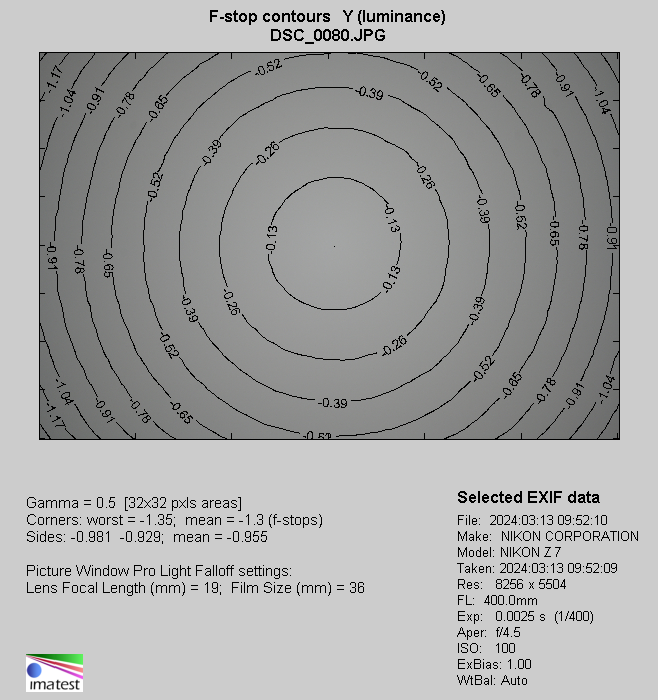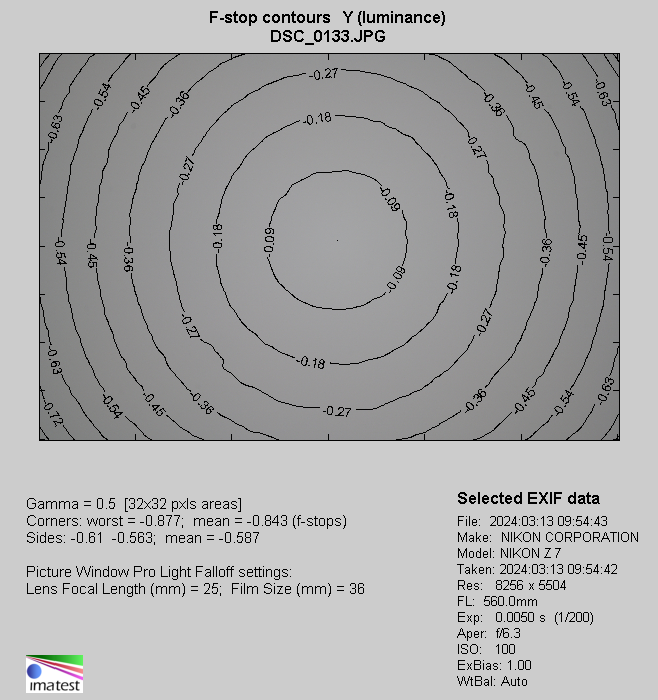Nikon Nikkor Z 400 mm f/4.5 VR S
8. Vignetting
| Nikon Z7, 400 mm, APS-C/DX, f/4.5 | Nikon Z7, 400 mm, APS-C/DX, f/5.6 |

|

|
Here there are practically no reasons to complain. At the maximum relative aperture brightness loss in frame corners amounts to 20% (-0.65 EV) and it decreases to an imperceptible level of 8% (-0.23 EV) on stopping down the aperture to f/5.6.
Please Support UsIf you enjoy our reviews and articles, and you want us to continue our work please, support our website by donating through PayPal. The funds are going to be used for paying our editorial team, renting servers, and equipping our testing studio; only that way we will be able to continue providing you interesting content for free. |
- - - - - - - - - - - - - - - - - - - - - - - - - - - - - - - - - - - - - - - - - - - - - - - -
Now let's check the situation after passing to full frame – appropriate thumbnails we present below.
| Nikon Z7, 400 mm, FF, f/4.5 | Nikon Z7, 400 mm, FF, f/5.6 |

|

|
Here the results are higher but, in an era of tests conducted on densely packed full frame sensors of mirrorless cameras, you still can call them moderate. By f/4.5 we got a result of 36% (-1.30 EV), that changes to 23% (-0.77 EV) when you stop down the aperture to f/5.6. Problems end completely by f/8.0 and f/11.0, where we got the following results: 6% (-0.17 EV) and 2% (-0.06 EV).
Still it's worth noticing that, even though vignetting at the maximum relative aperture in the very corner of the frame is perhaps not especially bothersome, its profile indicates that it appears quite fast as you move away from the frame centre. Our image with isophotes at the end of this chapter shows it very well.
Now let's describe the performance of the tested Nikkor after attaching the 1.4x teleconverter. Thumbnails we got on the APS-C/DX sensor are presented below.
| Nikon Z7, 560 mm (TC), APS-C/DX, f/6.3 | Nikon Z7, 560 mm (TC), APS-C/DX, f/8.0 |

|

|
After attaching a teleconverter the vignetting performance often improves. In this case we observe exactly that – at the maximum relative aperture you deal with a very slight value of 13% (-0.40 EV), that decreases to an imperceptible level of 2% (-0.06 EV) on stopping down the aperture to f/8.0. As you see, the situation is splendid.
How will it change after passing to full frame? Let's find out!
| Nikon Z7, 560 mm (TC), FF, f/6.3 | Nikon Z7, 560 mm (TC), FF, f/8.0 |

|

|
In this case the results are better than without the teleconverter because by f/6.3 we got 25% (-0.84 EV), and by f/8.0 that level decreases to 12% (-0.39 EV). This aberration becomes completely imperceptible by f/11.0, where it reaches just 3% (-0.09 EV).
| Nikon Z7, 400 mm, FF, JPEG, f/4.5 |
 |
| Nikon Z7, 560 mm (TC), FF, JPEG, f/6.3 |
 |






